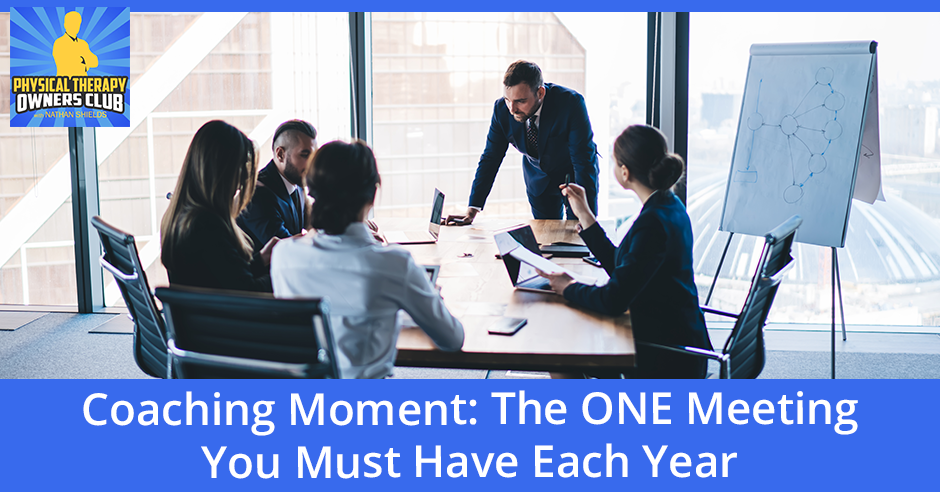
If there was ONE meeting you should have each year in your business, what would it be? In this episode, Nathan Shields talks about the MOST valuable annual meeting that an owner should have – the Annual Strategy Session. This is the one meeting in which you can step aside from the day-to-day and assess your business as a whole – weak points, strengths, upcoming issues, internal dilemmas, etc. – all at once.
The Annual Strategy Session can invigorate you and your team while coming together to determine what items are essential to achieve our goals this year. It’s a highly valuable meeting and a MUST for clinic owners. Listen to this episode to discover tips on how to have successful annual strategy sessions.
—
Listen to the podcast here:
Coaching Moment: The ONE Meeting You Must Have Each Year
I want to talk about the one meeting that you’ve got to do every year especially if you have a partner and a leadership team. Even if it’s you running solo, the important meeting that you have to have is one of an annual strategy session. The annual strategy session allows you the opportunity, especially with your team, to focus on what’s most important over the upcoming new year. Take your heads up out of the muck and the mire of the day-to-day activities that you’re performing and focus on the business. Look at the bigger picture. Look at the things that are coming up down the road so you can address them appropriately and in a timely manner so that you’re not that you’re being proactive and not reactive.
The annual strategy session that I did and most people do, was usually done at the end of the year, looking forward to the next year or at the beginning of the year that they’re in, trying to look forward to seeing what they want to accomplish in the upcoming year. The annual strategy session’s goal is essentially to get clarity on what are the most important action items that will move your company forward and clarify your goals for the year. It also allows you to recommit to your purpose and values and assess your business from a greater perspective including weak points and potential threats. The beauty behind an annual strategy session is it gets everybody on the same page if there’s more than just you. It allows you to focus on the business and what you want to get out of it.
When you’re looking at the number of things that you want to do and accomplish over the course of the year, everything can seem like it has high priority. There could be many tasks out there that you’re not sure which ones are most important, which ones are most vital to accomplishing what you want to accomplish in your business. It’s my recommendation that you do this on an annual basis. You can move your company forward, clarify your goals, reassess your purpose and values. Get a 30,000-foot perspective, reassess business from a greater perspective, including the weak points and the potential threats that are coming up down the road.
One of the recommendations that I have and it’s a shameless plug because I offer this as part of my coaching program but it is to utilize a third-party, someone outside of your organization to guide you, challenge you, force you to be clear on what you want to obtain. It will force you to actually put words to the things that you’re talking about not just the thoughts that are in your head but words to your concerns or what your goals are. Enforce that clarity to be verbalized.
It’s someone you can even be accountable to in the future. It’s important in these situations to be most effective, to recognize that there must be a commitment to brutal honesty and recognition of those pink elephants that could be in the room. A lot of you might not have heard of pink elephants before. The pink elephants are the 500-pound gorillas that are sitting in the corner, the sacred cows.
Recommit to your purpose and values and assess your business from a greater perspective yearly. Click To TweetA lot of times, especially in a group setting or in a partnership, there could be things that are going unsaid that need to be addressed that are irksome or could be a bone of contention between a partnership or even within a leadership group. The sacred cows are those things where we all believe a certain thing to be true, even though it might not necessarily be that way.
A sacred cow in physical therapy might be something along the lines of we don’t treat that way because it’s unethical. Maybe it’s not unethical but that’s just a sacred cow that we’ve postulated and we need to consider if that’s true or not. A 500-pound gorilla could be some serious issues that partners might have between each other and they’re just not addressed or haven’t been addressed to that point. These are your pink elephants. You need to be brutally honest with each other and amongst the group to recognize that there could be a pink elephant in the room that needs to be addressed.
It’s during these annual strategy sessions in which you can address those things if they haven’t been addressed to that point. That’s a good time to do that to make sure you’re all-purpose and value-aligned. Where do you start with an annual strategy session? The first part that I take people through is to envision their ideal scene at the end of the upcoming year. After 3 to 5 years, look and see what you want to accomplish at the end of this year but then also push it forward to see what that looks like 3 to 5 years down the road.
Take that ideal scene and compare it to the current scene. That gives you an understanding of where the gap lies. I want to get to this point but I’m at this point. It helps you understand where you need to get to and where you’re starting from. I recommend this be done on both the business and the personal side because more than likely, as an owner at least, your business actions are helping your personal actions and your personal actions, vice versa. It’s not something that the personal side of things necessarily needs to be shared if there’s a large group of you but it’s important to recognize that our personal and our business are significantly intertwined. Starting with the ideal scene working backward, what’s our current scene, just to mind of the gap.
Next, reassessment of purpose and values, this is a time to discuss, “Are we living our values and fulfilling our purposes as a business?” This is a perfect time to readdress both the purpose and values as needed and discuss how to better fulfill and exemplify your purpose and values. Sometimes the values can be misconstrued over time. Maybe this is a good time to redefine the values if they’re not clear between all the members of the leadership group that’s in attendance. Just take some time. It could be a small exercise. It could be longer if these aren’t well-stated but it’s important to readdress them every year and see how things are going.

The next step is what most people are used to when it comes to an annual strategy session. A lot of people have gone through typical SWOT analysis. SWOT is an acronym that stands for Strengths, Weaknesses, Opportunities and Threats. SWOT analysis allows you to address what are your strengths, weaknesses, opportunities that are afforded to us in the upcoming future? What are the threats that we see on the horizon or currently existing internally?
One of the weaknesses of a SWOT is that it doesn’t assess past performance. However, that can be noted and addressed in the weaknesses and threats section of your analysis. Properly recognize we didn’t do things right in the past year, this is where it lays currently as a weakness or a threat that still currently exists and needs to be addressed going forward.
Most people do a SWOT analysis and that’s about where they start. They do this, they take a few minutes to write down the SWOT and put some goals associated with it. If you’re doing this right, I should have said it from the forefront, these annual strategy sessions should be done in about a 3 to 6-hour period depending on what you’re assessing and the size of your business.
If you’re doing it within a single 30-to-60-minute period then that’s not enough time to discuss, analyze and assess. In fact, I did an annual strategy session with a client and took us from 10:00 AM up until 8:00 at night and this was a single practice. It takes some time to hone in on what’s happening within your business and in order to do that, you have to take the time and set aside the time to do it.
This is a great opportunity if you have a leadership team, to do a getaway, go someplace off-campus, away from family, away from the business or to go to a business center conference center. Stay overnight at a location and have dinner together after the fact. This is a great opportunity to do one of these getaways and to go through this annual strategy session.
Envisioning your ideal scene at the end of the upcoming year helps you understand where you need to get to and where you're starting from. Click To TweetNext, after doing the SWOT analysis, it’s important to break all of these down, strengths, weaknesses opportunities and then flip those that are weaknesses and threats into opportunities. It’s not that you’re just taking those and saying, “That’s an opportunity.” Rather, just reword it. If you were to say, “One of the weaknesses of our organization is that we don’t have a completed policy and procedure manual.”
How would you flip that? You would flip that by saying, “We have a completed policy and procedure manual. That’s one of our strengths and that’s an opportunity we could take advantage of.” If you wanted to take it further where if one of your strengths was, “We have a great leadership team,” you could say, “We have a strong policy and procedure manual that is supported by a strong leadership team.” That would be an opportunity to address in the upcoming year.
You take all these opportunities after getting rid of the weaknesses and threats, rewording them to make them opportunities and you break them down and filter those out until you come down to your 4 or 5 top priorities for the upcoming year. Sometimes it takes some discussion and it’s important to recognize that this isn’t a top priority for the upcoming year or this is a top priority for next year. It’s just not a priority for this year. It takes some discussion after going through the whole SWOT, writing up and switching those weaknesses and threats and rewording them into opportunities.
It takes some real discussion amongst the group to get down to 4 or 5 top priorities for the next year. Maybe some that are super important get left off to the side but you have to sit down. You can’t do ten. You have to break it down and get to 4 or 5 top priorities for the year. Break it down, filter it down to 4 to 5 top priorities.
Next, set goals for each of those priorities. Goals that would be accomplished preferably in the next year. Each priority gets a goal associated with it. That is measurable. We still have to remember the smart acronym when it comes to these goals but make sure it’s measurable and can be accomplished within the next year. Work backward and set quarterly goals for each priority and goal along with some initial action items.

It’s important to make sure these goals are measurable but it’s also important to then next assign those action items, assign these priorities to members of your leadership team, if you have one. That’s the beauty of doing this whole exercise with a leadership team. Some of your leadership team might be aligned with certain priorities or actually within their department are actually responsible for those priorities and the goals to be met. For example, if you have a marketing goal and you have a marketing person, that person is going to be responsible for that goal and that priority for the next year to get that goal accomplished.
That gives them a lot of inspiration but also accountability to achieve that. It’s important to do this with other team members if you’re able to. It’s important to get their insight, the beauty of doing this with a third person to lead it out is that many times members of the leadership team, if they are present might not feel comfortable addressing certain issues. They might feel like they need to deflect to the owner.
Maybe they feel like their voices aren’t quite heard or don’t want to speak up because that might be counter to what the owner has said in the past. The beauty of having a third person navigate or moderate this annual strategy session is vital because it helps their voices be heard. It addresses the pink elephants that may need to be addressed. It also holds the entire team accountable for equally shared voices.
I’d highly recommend a third-party doing this especially if you have a leadership team involved so that the owner doesn’t have the loudest voice in the room. After getting all this done, we’ve gone through ideal scenes, we’ve done the SWOT analysis, we’ve assessed our purpose and values and we’ve got goals and action items in place. Everyone’s well aligned for this entire next year. We know what we need to do. We know the goals that we want to accomplish. We have metrics in place to measure them. The last thing we need to do is celebrate.
It’s time to celebrate what we’ve accomplished in this session alone. Gather some excitement going forward as a team. Celebrate with dinner, do a team-building activity, you name it. Go do something together to celebrate being a part of this group that we are aligned within shared purpose and values. The one meeting that you need to have each year to focus yourself and achieve the goals that you want to achieve for the next year and more is going to come down to doing the same version of this annual strategy session to put you on the path for success for the next year. That’s my coaching moment.
Love the show? Subscribe, rate, review, and share! https://ptoclub.com/
